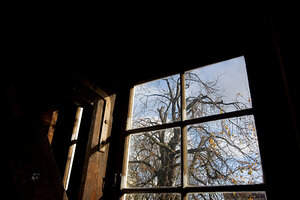Why Anne Frank's tree stood for so much
Hans Westra, executive director of the Anne Frank House in the Netherlands, says the dreams of the world-famous Jewish girl who died in the Holocaust came to be tied up in the 150-year-old chestnut, which came down in stormy weather.

In this Nov. 2007 file photo, the chestnut tree which comforted Anne Frank while she hid from the Nazis during World War II, is seen from the attic window in the secret annex at the Anne Frank House in Amsterdam, Netherlands.
Peter Dejong/AP/File
London
A day after the 170-year-old chestnut tree that stood outside the Anne Frank House was felled by stormy weather, I called Hans Westra, executive director of the Anne Frank House in Amsterdam, to talk about how and why a tree falling down can become such front-page news.
Anne Frank, the teenage Jewish girl who chronicled her experiences hiding in an attic in Nazi-occupied Holland, received international acclaim when her diary was discovered and later published after her death in a concentration camp. The chestnut tree outside her Amsterdam hideout was a frequent feature of her bleak picture of World War II in Western Europe.
“It’s a tree with a long history,” he begins. “All the other windows in the house were covered by curtains, and the attic was the only room out of which Anne Frank could properly see without fear of anyone seeing her. So, she would sit there and look out at the sun and the top of the chestnut tree. All her longing for freedom came to be tied up with that tree.”
I wanted to know: Do we need tangible aids to help us comprehend and remember the Holocaust? When Anne Frank’s chestnut tree falls, as has just happened, or, even more to the point, as the survivors pass away, is it then harder for new generations to connect with and understand the Holocaust?
"We are doing everything we can to keep this story alive," says Mr. Westra. "For example, we have created a website where you can see the original tree and also go through the rooms of the house and into the secret annex. And we have also captured testimony from many of the witnesses to Anne Frank’s story on film.”
Westra marvels at the legacy of Frank's experience over time. “What is remarkable actually is how much the younger generation remains interested in this history," he says. "Our visitors are typically six or seven years younger than the visitors of any other museum in the city. And this is not a story that speaks only to Jews or Dutch. People come here from all over the world – from China, Argentina, Russia ... everywhere.”
How, in general, does one explain the enduring power of the Anne Frank story? Why do so many people still come to Amsterdam to visit the house, and continue to read her diary?
“Anne Frank’s suffering stands as a symbol of a much larger story, and people want to connect to that,” responds Westra. “Moreover, she was a fantastic writer and her diary is a lovely story that people relate to. It’s a story of a young girl, having trouble with her mother, interested in boys, and wrestling with her future. It's such a normal story, mixed up with the tragic story going on outside – and it has become a window on the Holocaust that people can identify with.”
